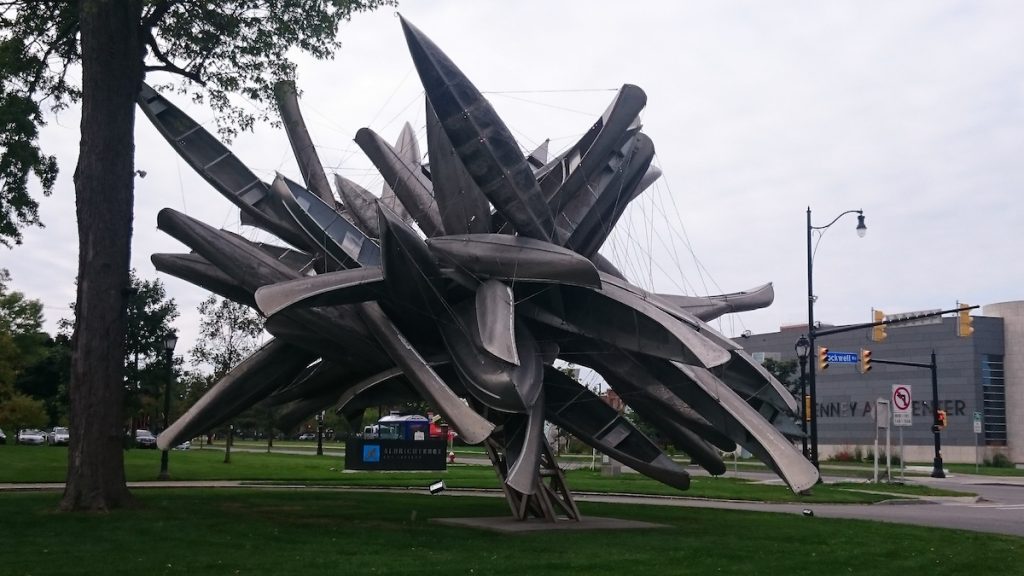Photo: “The Canoes” by Nancy Rubin outside the Albright-Knox in Buffalo.
I’ve come to Buffalo as an artist-in-residence with the Open Air Institute at SUNY Buffalo’s Department of Media Study. Open Air Director Teri Rueb is my mentor and guide. The first time I met with her, she drove me around the neighbourhoods of the Delaware Park System, pointing out the Frederic Olmsted-designed roundabouts and diagonal parkways that cut across the grid. The houses are big, inexpensive to rent but expensive to heat in the winter. Elmwood Avenue is where the restaurants and shops are in this part of the city. Built Environment Strata.
On my second visit, I cross the Peace Bridge into Buffalo in the evening, heading to a department dinner party, and the border guard is the friendliest I have ever met. She smiles, asks her questions politely, waves me through. The party is in Parkside, a national historic district that also contains two Frank Lloyd Wright houses. At the house, people stand in the backyard in the dusk, slapping hungry mosquitos that have come out in force in the humid, cooling air. Sensual Strata, Nature Strata, Geopolitical Strata. I ask people I meet to tell me stories about Buffalo and border-crossing. Our host tells me he lived in Toronto for 12 years and commuted here, and somehow got on some sort of list where they pulled him over for document control every single time, until after two years, his name must have fallen off the list. Storied Strata.
On my third visit, I cross the Peace Bridge late at night, only one kiosk open at the border. Again the guard is friendly. I have brought my funding papers in case they might prevent another document-control pullover, but he doesn’t even ask to see them. Navigating through the Buffalo streets in the dark, guided only by the disembodied female voice of GPS, I have no idea where I am. I feel like I am steering a spaceship through the void of the unknown. Red brick buildings, churches, laundromats. Finally she says, “you have arrived at your destination.” Technological Strata. Networked Strata.
In the morning I go to the Albright-Knox. Driving up Elmwood, I see a store called WE NEVER CLOSE! It has been about 15 years since my last visit. I walk around the building, looking at the sculptures. Shapes and colours in the landscape, Delaware Park across the way, the water gleaming in the sunlight. Inside there are drawings by the artist Joan Linder: a map of toxic waste sites, panaromic drawings of landscapes and chain-link fences which I feel an immediate kinship with (as I myself had a long-standing relationship with the L’Acadie Fence). I am in awe of these drawings and her project, called “Operation Sunshine.” Industrial strata. Storied Strata. There is also a 2 channel video installation by Claudia Joskowicz called “Every Building on Avenida Alfonso Ugarte—After Ruscha” (that included a copy of Ed Ruscha’s fold-out accordion book, “Every Building on the Sunset Strip”, something I have referenced often and was delighted to see). Joskowicz’s work takes the mundane drive down a street in El Alto, Bolivia, punctuated with scenes from a protest and a celebration. I watched the video twice, entranced by the rolling cinema of the street. What else could I call these brushes with the thoughts and obsessions of another, this feeling of kinship, this view of the world from another’s perspective that has now overlaid itself on the landscape of this place? Connection Strata. Emotion Strata. Spark Strata.
Naturally, the first sites tend to be the tourist spots, the places that build the bones of the city image. I am a tourist, yes, but I am developing my de-touring skills so that I can be a (de)tourist. De-touristing implies an attempt to move past stereotypically tourist practices, which tend towards sight-seeing and spectacle. Shifting emphasis from “sight to site” (as Guilana Bruno recommends in her Atlas of Emotion), my conception of detouristing uses these stratigraphic methods to found a de-touristing practice that promotes the deeper understanding of place. Filling in the blanks of the map is an endeavour of years, decades, lifetimes. In my short tenure in Buffalo, I can hope for no more than the slightest and most tentative sketch of the city, but already my cognitive map is so much clearer than just two months ago.
